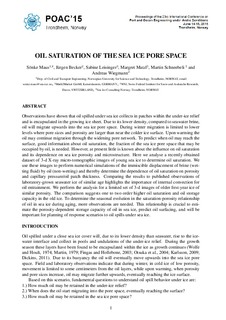| dc.contributor.author | Maus, Sønke | |
| dc.contributor.author | Becker, Jurgen | |
| dc.contributor.author | Leisinger, Sabine | |
| dc.contributor.author | Matzl, Margret | |
| dc.contributor.author | Schneebeli, Martin | |
| dc.contributor.author | Wiegmann, Andreas | |
| dc.date.accessioned | 2018-04-26T07:03:42Z | |
| dc.date.available | 2018-04-26T07:03:42Z | |
| dc.date.created | 2015-09-21T09:56:34Z | |
| dc.date.issued | 2015 | |
| dc.identifier.citation | Proceedings - International Conference on Port and Ocean Engineering under Arctic Conditions. 2015, 2015-January . | nb_NO |
| dc.identifier.issn | 0376-6756 | |
| dc.identifier.uri | http://hdl.handle.net/11250/2496030 | |
| dc.description.abstract | Observations have shown that oil spilled under sea ice collects in patches within the under-ice relief and is encapsulated in the growing ice sheet. Due to its lower density, compared to seawater brine, oil will migrate upwards into the sea ice pore space. During winter migration is limited to lower levels where pore sizes and porosity are larger than near the colder ice surface. Upon warming the oil may continue migration through the widening pore network. To predict when oil may reach the surface, good information about oil saturation, the fraction of the sea ice pore space that may be occupied by oil, is needed. However, at present little is known about the influence on oil saturation and its dependence on sea ice porosity and microstructure. Here we analyse a recently obtained dataset of 3-d X-ray micro-tomographic images of young sea ice to determine oil saturation. We use these images to perform numerical simulations of the immiscible displacement of brine (wetting fluid) by oil (non-wetting) and thereby determine the dependence of oil saturation on porosity and capillary pressure/oil patch thickness. Comparing the results to published observations of laboratory-grown seawater ice of similar age highlights the importance of internal convection for oil entrainment. We perform the analysis for a limited set of 3-d images of older first-year ice of similar porosity. The comparison suggests one to two order higher oil saturation and oil storage capacity in the old ice. To determine the seasonal evolution in the saturation-porosity relationship of oil in sea ice during aging, more observations are needed. This relationship is crucial to estimate the porosity-dependent storage capacity of oil in sea ice, predict oil surfacing, and will be important for planning of response scenarios to oil spills under sea ice. | nb_NO |
| dc.language.iso | eng | nb_NO |
| dc.publisher | Port and Ocean Engineering under Arctic Conditions, POAC | nb_NO |
| dc.relation.uri | http://wxreview.org/temp/POAC15/pdf/poac15Final00244.pdf | |
| dc.title | Oil saturation of the sea ice pore space | nb_NO |
| dc.type | Journal article | nb_NO |
| dc.type | Peer reviewed | nb_NO |
| dc.description.version | publishedVersion | nb_NO |
| dc.source.pagenumber | 12 | nb_NO |
| dc.source.volume | 2015-January | nb_NO |
| dc.source.journal | Proceedings - International Conference on Port and Ocean Engineering under Arctic Conditions | nb_NO |
| dc.identifier.cristin | 1265890 | |
| dc.relation.project | Norges forskningsråd: 243812 | nb_NO |
| dc.description.localcode | © 2015 Port and Ocean Engineering under Arctic Conditions. Available at http://www.poac.com/Papers/2015/author_index.htm | nb_NO |
| cristin.unitcode | 194,64,91,0 | |
| cristin.unitname | Institutt for bygg- og miljøteknikk | |
| cristin.ispublished | true | |
| cristin.fulltext | original | |
| cristin.qualitycode | 1 | |
